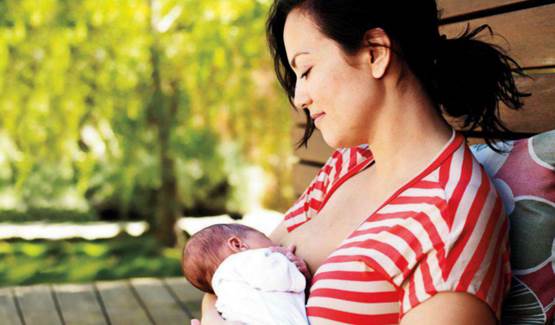What to do now, and after the baby
arrives, to bolster breastfeeding success
When I gave birth to my twins a few years
ago, I thought I knew a thing or two about breastfeeding. My older son had
nursed for 14 months with nary a problem, and I'd been researching, writing and
editing breastfeeding articles for this magazine for more than 10 years.
Turns out there were a few things I didn't
know- little things like how to maneuver two tiny bodies onto the nursing
pillow to tandem-nurse. Lucky for me, though, my friend Keri a mother of not
one but two sets of twins-swooped in to help. She was there for me with
soothing words of confidence, practical help and more than a few desperately
needed healthy meals.

What
to do now, and after the baby arrives, to bolster breastfeeding success
According to Nancy Mohrbacher, I.B.C.L.C.,
F.I.L.C.A., a lactation consultant near Chicago and a co-author of
Breastfeeding Solutions: Quick Tips for the Most Common Nursing Challenges (New
Harbinger Publications), it's help like this that can make all the difference
in a woman's decision-and, ultimately, her ability-to breastfeed. "Moms
helping moms-with support, with advice, with hands-on help-is one of the best
ways for women to succeed," she says. Want more tried-and-true ways to
guarantee success for yourself? Read on.
1. Hang with new moms
"Attend a breastfeeding support group
or baby-care class before you have the baby," Mohrbacher advises. The goal
is to spend time with other women who are already breastfeeding so you can not
only learn from them, but find that all-important source of support for when your
baby arrives. Doing so also helps you to develop what Mohrbacher calls
"breast- feeding self-efficacy," or the belief in your own ability to
breastfeed. "Being around other women who are nursing helps you to develop
confidence and commitment, which is a very powerful force in helping you to
succeed," she explains. Bring your partner, mother, even your mother-
in-law to these groups and classes, as you'll want them to support your
decision to breastfeed. And, of course, keep up with the group once you're
nursing your own baby.
2. Talk to your baby doc
Spend time interviewing potential
pediatricians while you're still pregnant-and make sure yours recognizes and
supports the importance of breastfeeding. "If a health care provider isn't
completely supportive of your decision to breastfeed, find someone who
is," advises Suzanne Haynes, Ph.D., senior science adviser at the Office
on Women's Health in the U.S. Department of Health and Human Services. Support
from your pediatrician can have a huge effect on your commitment and success.
According to a 2003 study, women who received encouragement from their health
care clinicians were much less likely to discontinue breastfeeding within the
first 12 weeks.

Spend
time interviewing potential pediatricians while you're still pregnant-and make
sure yours recognizes and supports the importance of breastfeeding
3. Choose where you'll deliver
If you have any options in where you'll
have your baby, aim for a facility with a low Cesarean section rate-preferably
less than 20 percent, says midwife Ina May Gaskin, author of Ina May's Guide to
Breastfeeding (Bantam). According to a 2010 Italian study, C-sections are
associated with lower rates of breastfeeding in the delivery room as well as
exclusive nursing in the immediate postpartum period. (It's important to start
nursing as soon as possible after delivery to help establish a healthy milk
supply.)
Even better, deliver at a
"Baby-Friendly" hospital or birth center; these facilities have
received hard-won distinction for their dedication to breastfeeding. Though
only 154 facilities in the U.S. have been given this designation so far, 90
more are in the process of becoming accredited. (Visit babyfriendlyusa.org for
more information.)

According
to a 2010 Italian study, C-sections are associated with lower rates of
breastfeeding in the delivery room as well as exclusive nursing in the
immediate postpartum period
If you can't deliver at a Baby-Friendly
hospital or birth center, Haynes advises asking potential hospitals for their Perinatal
Care core measure set from the U.S. Centers for Disease Control and Prevention
and the Joint Commission on Accreditation of Healthcare Organizations.
According to Haynes, this report measures the number of mothers who were
exclusively breastfeeding at the time of discharge from the hospital. "You
want to look for a high percentage," she says.
4. Insist on late cord clamping
Waiting a few minutes to cut the umbilical
cord allows the baby to receive more iron-rich placental blood, Gaskin says.
This extra boost can help your baby breastfeed more vigorously. "Ask your
doctor to wait until the cord stops pulsing before the cord is cut," she
advises.

Late
umbilical cord clamping makes for a more robust baby
5. Get semi-horizontal
Rather than nursing in the usual sitting-up
position, Mohrbacher suggests adopting a semi-reclined position to ease strain,
"Recline the hospital bed or place pillows behind your back so your body
is completely supported and your shoulders are relaxed, then place the baby belly
down, directly on your chest," she advises. Mohrbacher also notes there
will be some trial and error until you find what's most comfortable for you,
and that the position in which you like to watch TV often works best. (For a
visual of how to nurse your baby this way, visit
fitpregnancy.com/reclinedposition.)